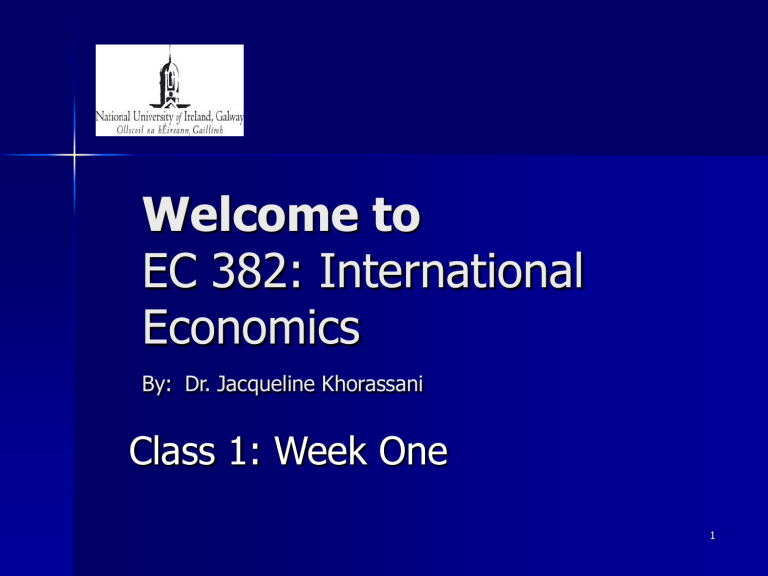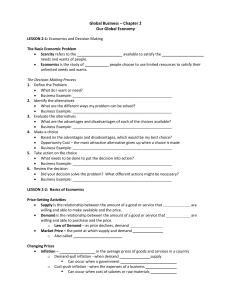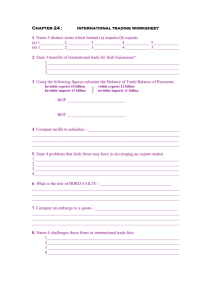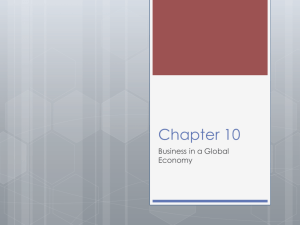class1

Welcome to
EC 382: International
Economics
By: Dr. Jacqueline Khorassani
Class 1: Week One
1
Week One: Day one
Tuesday, September 4
14:00-14:50
AC 202
2
What should you do?
Study the Course Contract available on line at www.marietta.edu/~khorassj
– Click on Fall 2007 Courses
– Click on EC 382: International Economics
– Click on Course Contract
– It is in Microsoft Word format
Make sure you understand the contract
Ask me questions via an email to khorassj@marietta.edu
or jacqueline.khorassani@nuigalway.ie
.
3
Highlights of the Contract
What is this course about?
Is an international transaction different from a transaction within a nation?
In many ways an international trade is no different from an exchange within a nation.
Yet, international exchange raises new and different concerns. Why?
4
International trade occurs between independent nations
The auto shipments from the USA to
Ireland may be disrupted if the
Ireland’s government imposes a new quota against American cars.
Also, a sharp depreciation in the US dollar against the euro will suddenly make American cars cheaper to Irish consumers. Neither of the above events can happen within a given country.
5
Means of Communication
1.
2.
3.
Class
Tuesdays: 14:00-14:50 in AC202
Wednesdays: 11:00-11:50 in Tyndall Theatre
Wednesdays: 15:00-15:50 in AC201
Note: No Class ob Thursday
My website
www.marietta.edu/~khorassj
1.
khorassj@marietta.edu
2.
Jacqueline.khorassani@nuigalway.ie
6
Means of Communication
4. Office
310 St. Anthony’s
Phone: 091- 493105 (office)
Hours
Mondays: 14:00-15:00
Tu & Th: 12:00-13:00
Wednesdays: 13:00-14:00
& by appointment.
5. Balckboard (More on this later.) http://balckboard.nuigalway.ie
7
My Teaching Philosophy
I am not a lecturer
– In other words, I am not going to be a
transmitter of knowledge.
I am a designer, a conductor, a coach
You are not knowledge sponges
You are knowledge constructors
8
My tasks
1. Design a map that will lead you toward the construction of your knowledge.
–
Study guides will be posted on my website in the beginning of each week.
2. Help you figure out how to ask the right questions when you feel lost.
3. Ask you questions in an attempt to find out if you are on the right track.
4. Give clear and meaningful answers to your questions.
–
PowerPoint slides of the classroom activities will be posted on my website at the end of each week.
9
Your tasks
1.
2.
3.
Study and follow the map
Ask questions when you feel lost
– A dumb question is better than no question
Respond to my questions
– Be prepared to be wrong sometimes
– This is not a test.
10
Our joint task
is to build a learning environment in which we feel free and comfortable to express our thoughts; to respectfully disagree with each other at times; and to learn from each other.
11
Texts
International Economics by Sawyer and Sprinkle, Prentice Hall, 2006
&
Financial Times
12
Examinations
2 exams
1. Exam 1: Wednesday, October 10, 15:00
– 16:00 (20% of grade)
2. Exam 2: Will be determined by the
University later (60% of grade)
13
Just in time Assignments
20% of course grade
14
Study the textbook’s
Preface
Believe me it is not a waste of time to read the Preface of a book
Ask me questions via an email.
15
Check out the textbook resources at http://www.prenhall.com/sawyer/
16
Chapter 1 (If don’t ask questions, I assume that you don’t need my help.)
Macro/Microeconomics
– How are they different from each other?
Micro: studies the production and consumption of various goods and services and how particular industries and markets work
Macro: studies the operation of the entire economy and the factors that determine the economy’s total output
17
Week One: Class 2
Wednesday September 5
– 11:10- 12:00
– Tyndall
18
I received questions; thank you.
1.
About the textbook
Unavailable for 2 weeks?!!
Does the library have it?
If not, I will leave a copy at the Media
Services in this building (Printing
Services) this afternoon.
19
I received questions; thank you.
2.
About the purpose of a study guide
You don’t need to turn in anything
You just do what it says
If you don’t understand something or have questions, ask me
Beginning in week 2
If I don’t get any questions on a certain topic, I may not discuss it in class. But you are responsible for that topic.
20
I received questions; thank you.
3.
The book’s resources online
What are they good for?
Sample questions
Study guide
I will not directly refer you to the book’s online resources.
21
International Economics
What is it all about?
– Explains patterns of international transactions
Is free trade good or bad?
Are trade barriers good or bad?
Is it good to have for the euro to appreciate or depreciate against dollar?
22
Is this Macro or Micro topic?
The effect of a trade barrier on the overall unemployment rate in Ireland.
– Macro
The effect of import quotas on the production of cars in the US
– Micro
International Economics requires both
Micro and Macro economic analysis
23
GDP
What does it measure?
– Market value of all final goods and services produced within a country in a given period of time
Why do we measure GDP?
– It is a measure of output, income (with some adjustments) and economic well being.
24
GDP
What are the components of GDP?
– GDP = C + I + G + (X – M)
What is per capita GDP?
– GDP divided by population
25
The Output of the World Economy
Table 1.1: Distribution of World Population and Economic
Output, 2002
Total GDP
(millions of $)
% of World
GDP
GDP per Capita
Low-Income
Economies
Middle-Income
Economies
$451
$1,877
High-Income
Economies
Source: World Bank, 2004
$26,964
Population
(millions)
% of World
Population
2,494.6
2,737.8
966.2
40.2%
44.2%
15.6%
$1,123,865
$5,139,306
$26,052,812
3.5%
15.9%
80.6%
26
What is the relationship between a nation’s income and its exports? Imports?
Empirical Evidence: high income economies import and export more than middle and low income economies .
27
Imports and Exports of Goods in the World Economy
Table 1.2: Distribution of Imports and Exports of Merchandise in the World Economy
(2002)
Low-Income
Economies
Middle-Income
Economies
High-Income
Economies
World Total
Source: World Bank, 2004
Imports
(millions of $)
% of World
Total
$197,606 3.0%
Exports
(millions of $)
$211,197
$1,364,003
$5,028,663
$6,590,272
20.7%
76.3%
$1,447,025
$4,796,707
$6,454,929
% of World
Total
3.3%
22.4%
74.3%
28
What are the multinational corporations?
Companies that own, control, or manage production and distribution facilities in several countries
29
What is the difference between foreign portfolio investment and foreign direct investment?
1.
2.
portfolio investment
– The purchase of financial assets
For example, stock and bonds, in a foreign country direct investment
– A domestic corporation’s purchase of real assets
For example, plant and equipment, in a foreign country
30
Week One: Class 3
15:10-16:00
AC 201
I will leave a copy of Chapters 1-3 at the Media Services in this building
(Printing Services) tomorrow.
No class tomorrow
Don’t miss our class next week
There is going to be an in class assignment.
31
What is foreign exchange market?
The market where currencies are bought and sold
Exchange Rate
– The price of one currency in terms of another currency
Today, €1= $1.4
What if tomorrow €1= $1.8
– Dollar depreciated and euro appreciated
32
Chapter 2
What are the similarities and the differences between international and interregional trade?
Similarities
– Florida can produce oranges cheaper than Ohio so it sells oranges to Ohio.
Both states benefit
– Italy can produce wine cheaper than Ireland so it sells wine to Ireland.
Both countries benefit
33
Differences
– Orange producers in Ohio lose their jobs
No so bad???
– Irish wine producers lose their jobs
Bad???
34
Questions (Copy these questions please.)
1.
2.
3.
4.
Why do the two nations trade?
How does the trade affect the price in each country?
Is everyone better off?
What is the effect of trade
– Consumers in each nation?
– Producers in each nation?
35
Trade in an
Individual Product
Figure 2.1: The Effects of Trade on Production, Consumption, and the Price of Cloth
Price of Cloth Price of Cloth
S
U.S.
E
P
U.S.
P
1 i j
P
1
S
INDIA p *
P
2 n c
Imports d r
D
U.S.
p *
P
2
P
INDIA g h a
Exports b k m
F
D
INDIA
Q
1
Q
U.S.
Q
2
U.S. Cloth Market
Quantity of Cloth Q
3
Q
INDIA
Q
4
India’s Cloth Market
Quantity of Cloth
36
Let’s re-visit the questions
1.
2.
3.
4.
Why do the two nations trade?
How does the trade affect the price in each country?
Is everyone better off?
What is the effect of trade
– Consumers in each nation?
– Producers in each nation?
37
Mercantilism (1700s)
A country should discourage imports and encourage exports in order to increase its wealth
Tariffs and quotas were used to restrict imports to cause a “favorable trade balance”
Trade is a zero sum activity
– Exporters gain, importers lose
38
Adam Smith (1723
(Scotland)-1790)
Trade is not a zero sum game
– Both exporters and importers win
– Nobody forces you to import
– If you import on your free will then you must gain from it.
39
What does absolute advantage mean?
If India can produce one yard of cloth using fewer resources than the US, then India has absolute advantage in production of cloth
Or
If India uses all of its resources it can produce more cloth than the US, then India has absolute advantage in production of cloth
40






